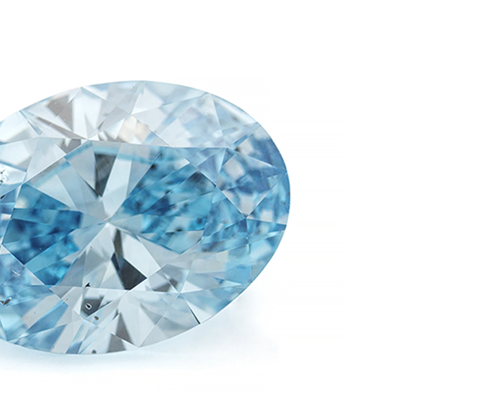
Using The 4 C’s To Determine The Price
The Four C’s of diamonds refer to Carat, Clarity, Color and Cut It’s an established practice to price white diamonds based on the characteristics of those four parameters. The price of COLORed DIAMONDS can also be determined this way. Click on each of the Four C’s for details.
Carat
In COLORed DIAMONDS, as in whites, the price increases with size, or carat. However, as the size of the stones increases, the price difference between white and Colored Diamonds of the same clarity increases phenomenally - whites become far more expensive. While small-sized diamonds used as the raw material for color enhancement have a value only slightly lower than similar sized white diamonds, as the color differences are not easily discerned by the naked eye, the larger near-colorless stones are much cheaper because their ‘off-color’ is more clearly visible. So this price difference in raw materials is reflected at the retail level as well.
Clarity
With COLORed DIAMONDS, just as with white diamonds, the higher the clarity of the stone, the higher its price. One important point is that color enhancement will not change the physical nature of inclusions but can heighten the visibility of certain inclusions, and thereby affect prices. For example, a feather in a blue enhanced diamond becomes more easily visible against a background color. Also, black piques in yellow diamonds tend to be more easily visible against the background. What this can mean is that a small feather that merits an I1 grading in a white diamond will result in a lower grading, such as I2, in a blue diamond.
Color
Prices Across Colors –
The reasons for price differences between colors have to do with the price of raw materials and the rate of success in producing the desired color. The reason black colored diamonds are cheaper than others is because they can be made using less expensive, naturally darker stones - and produced consistently in large quantities. On the other hand, pink and purple colored diamonds are more expensive because the success rate for production of these is always low.
Color Purity –
Within each color, price differences continue. Not all blues, for instance, are equal. A pure color, or single hue, will normally command a higher price than a mixture of hues, so a pure blue stone is more expensive than a blue-green one. A golden yellow diamond is more expensive than a greenish yellow.
Ideal Shade –
Every color has an ideal shade, and it differs with each color. With blues, a lighter shade is considered more valuable than a darker one. With yellows, the reverse is true.
Matching Capability –
Sometimes a diamond with an ‘off color’ can be beautiful individually, but if it can’t be matched or reproduced consistently, it will be sold at a considerable price reduction. It’s important that parcels of diamonds be identical in color, minimizing labor costs for matching.
Cut
As with white diamonds, the better the cut, the higher the price. However, with COLORed DIAMONDS, price is determined by an additional factor – the labor cost of matching the colors in similar-cut diamonds. Two diamonds might have the same body color when seen through the pavilion, but when seen face-up, if one has a shallower crown angle, it will look darker than the other. Wide variances in proportions across COLORed DIAMONDS will make them harder to match them face-up – incurring a higher cost of labor. This is especially an issue in smaller sizes when a larger number of pieces need to be matched.

